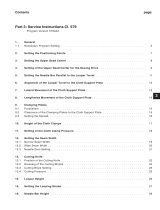
Index Page:
28.2 Fusesinthecontrolbox........................................... 84
28.3 Exchange of the control ........................................... 84
28.4 Adjusting the contrast of the control panel................................ 84
29. Service menu (technician level)
29.1 Activatingtheservicemenu ........................................ 85
29.2 Quittingtheservicemenu.......................................... 85
29.3 Menustructure................................................ 86
29.3.1Menustructurewithnumbers........................................ 88
24.4 Menu items configuration automatic buttonholer ............................ 90
29.4.1 Loading position ............................................... 90
29.4.2Menuitemthrowwidth............................................ 90
29.4.3Menuitemthreadmonitor.......................................... 91
29.4.4Menuitemdutycycleofcuttingblock................................... 91
29.4.5 Menu item sewing equipment ....................................... 92
29.4.6 Menu item threading mode ......................................... 93
29.4.7 Menu item operation mode ......................................... 93
29.4.8Menuitemtensiondata........................................... 94
29.4.9MenuitemMultiflex.............................................. 95
29.5 Menu items operating configuration.................................... 96
29.5.1 Menu item language ............................................. 96
29.5.2Menuitempush-buttons........................................... 96
29.5.3Menuitembrightnessofthesewinglamp................................ 97
29.5.4 Menu item key tones............................................. 97
29.6 Menuitemstestfunctionsmultitest.................................... 98
29.6.1Menuitemoutputtest............................................ 99
29.6.2 Menu item manual input test ........................................ 100
29.6.3 Menu item automatic input test....................................... 101
29.6.4Menuitemsewingmotortest........................................ 102
29.6.5Menuitemstepmotortest ......................................... 103
29.6.6Menuitemflashtest............................................. 104
29.6.7MenuitemRAM-test............................................. 104
29.7 Menu items test functions / Test program sewing sequence ..................... 105
29.7.1Menuitemstop................................................ 105
29.7.2Menuitemreferencestart.......................................... 105
29.7.3 Menu item continuous operation...................................... 106
29.7.4 Menu item checking the setting of the sewing instruments (Looper adjust) ............ 107
29.8 Menuitemevents............................................... 111
29.8.1Menuitemallevents............................................. 111
29.8.2Menuitemlatestevents........................................... 111
30. Error messages ............................................... 112
31. Troubleshooting............................................... 117
3


























